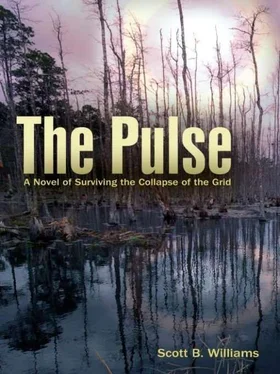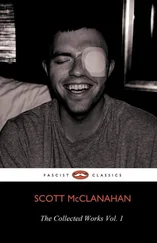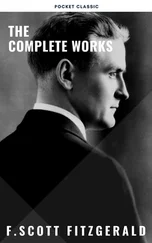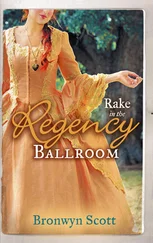As Grant and his companions pedaled along one of these long stretches between exits, several large black birds hopped to the top of the retaining wall while others took flight at their approach. There was no mistaking what they were—vultures—and they had been crowded around something lying along the shoulder of the right lane, which took shape as they drew nearer.
“Oh my God!” Jessica said, turning her eyes away as soon as she saw the figure clearly. It was the body of a very obese man, with graying hair, sprawled belly down on the hot pavement. He was dressed in business clothes, a tie around his neck, but his jacket was missing, probably discarded somewhere along the way as he walked in the sweltering heat. His sweat-stained Oxford shirt was untucked at the waist; one leather shoe was lying a few feet behind him, the other still on his right foot. His head was turned so that his missing eyes were unavoidable as they passed, as were the flies that swarmed around his open mouth. Grant felt a wave of nausea and dizziness sweep over him, and he got off the bike to push it to the far side of the left-hand lane and past the horrid sight. Casey and Jessica did the same; then Jessica turned pale, bent over, and puked. Seeing this, Casey couldn’t hold it back either. Three of the vultures still sat on the low concrete wall just a few feet from the body, watching them with beady black eyes, reluctant to fly away from their newfound meal unless seriously threatened.
“What do you think happened to him?” Casey asked Grant as she spit and coughed, trying to get the awful taste of vomit out of her mouth.
“Probably a heart attack or stroke,” Grant said. “It looks like he was trying to get to the exit like everyone else, but he was in no shape for that kind of exertion in this heat.”
“His eyes…did the…?”
“Yes, the vultures,” Grant finished for her. “They fight over them, from what I’ve seen of dead cows and such.”
Casey pushed her bike faster. She just wanted to get away from the scene as quickly as possible.
“Why did they just leave him to lie here like that?” Jessica asked.
“Who would have moved him? It’s not like anyone could call for an ambulance. The other people stuck here on this bridge would have been concerned with their own safety. He might have died before he even hit the ground. He’s too heavy for anyone to carry or drag very far, so where he fell is where he stayed.”
“That poor man,” Casey said, trying to visualize him as a living, breathing human being rather than the gruesome thing that she knew would be an image forever burned in her memory. “He probably has a family somewhere in the city, wondering when he’s coming home.”
“I’m afraid we’re going to see more of this,” Grant said. “The Causeway will probably be worse. There’ll likely be a lot of live people still stranded there too. Some of them will be too old, too young, too out of shape, or too disabled in some way to walk the long distance back to either end, especially if they were unlucky enough to be caught in the middle when the pulse hit. Others will probably already be dead. I wish we didn’t have to see that, but be ready for it. Just try to remember, we have to focus on our own survival. We probably can’t help them, and there’s probably not anyone who can really help us either.”
“WHO CAME UP WITH the stupid idea that these islands are some kind of paradise?” Artie yelled as he shook the water from his hair after another frantic plunge into the harbor. Incessant attacks from the tiny biting sand fleas that plagued their beach worksite in the otherwise calm early morning were driving him insane. They swarmed around his eyes, ears, scalp, and every exposed part of his body, biting with infuriating persistence that could only be relieved by diving underwater to wash them away, which was essentially futile, as it seemed a million more were ready to take their place as soon as he resurfaced.
Larry laughed at his brother’s antics. “You get used to them after awhile. Just learn to ignore them.”
“How am I supposed to ignore them when they are all over me? Damn! This is worse than being out there on the boat, throwing up day and night.” The passing of several days had pushed the memory of his miserable mal de mer far enough back in his mind that it now seemed like a minor inconvenience.
“Not’ing to be done ’bout de no-see-um,” Scully said. “Dem always on de beach when de air be still. Dat’s why a mon needs dreadlocks. Shake de dreads ’round an’ de sand flea, he got nowhere to stop. Keep de herb pipe handy too. Dem can’t fly in de smoke, mon.”
“And if they did, you wouldn’t feel the bite, right, Scully?” Larry grinned.
“Dats for true. A mon need de ganja smoke here in de island.”
Despite all the talk about Scully’s ganja smoking, Artie had only seen him light his pipe in the evening around the campfire they built on the beach near the boat shed. During the day, he was a tireless worker, which came as a surprise after all Larry had said about the Rastafarian philosophy, religion, or whatever it was. He was still confused about the unlikely friendship between his brother and this islander, but they certainly both knew boats, and their progress on putting Larry’s big catamaran together was astounding.
Most of the work consisted of installing hardware and fittings that Larry had previously purchased and had been planning to install after all the final painting and other cosmetic work was completed. With no time to worry about aesthetics or even the proper drilling and marine bedding techniques for long-term protection against rot in the wooden structures, these installations went fast. Scully drilled the holes with a manual brace and bit Larry had bought at a flea market years ago, and assorted hand chisels were used where mortises were needed to install flush fittings. Larry said the hardest part of building a boat from scratch was all the detail work that went into the final sanding, fairing, and painting to get a perfect finish, and since they were skipping all that, it only took a day to finish these installations. Then they were ready to assemble the major components—two hulls, bridge decks, crossbeams, and the mast—that as a whole made up the catamaran.
The second morning of work was consumed by this assembly. They used jacks and timber skids to move the hulls inch by inch out of their supporting cradles and slide the keels apart, and then aligned them fore and aft at the correct spacing so that the four massive connecting beams could be fitted. With the beams in place, Artie could see that Alegria was a much bigger vessel than at first it had seemed. The deck space was enormous. The central cockpit area between the two hull cabins was fitted with seats with storage lockers under them, while other deck areas fore and aft were made up of slatted wood planking or fabric trampoline material to allow breaking waves to quickly drain off. The cockpit area where the helm station was located was shaded by a curved, rigid Bimini cover, which Larry said he had molded from foam-cored fiberglass. The cabins inside the hulls were narrow and tunnel-like, but deep enough to allow standing inside without the need to duck. The forward area of each cabin featured a four-foot-wide, wall-to-wall double berth, with lots of locker space under for storing provisions. An additional single berth was fitted into a separate section of the port hull, forward of the main cabin area. The port hull also contained the galley, with a countertop, sink, and alcohol stove making up the area aft of the bunk. This same space in the starboard hull was taken up by the navigation station, which included a chart table, electrical circuit panels, and now-useless electronics such as the VHF and SSB radios, XM radio and MP3 player, and laptop with navigation software.
Читать дальше












